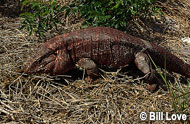Description:
Large predatory lizards like the red tegu need a large cage, minimally 4 feet long and 2 feet wide. An outdoor pen is even better, but great care must be given to burying the walls at least a couple feet deep to prevent them from digging out. In nature, red tegus are powerful tunnelers that make burrows many feet deep that are used for both nighttime shelters and egg-laying chambers. Never underestimate the red tegus ability to excavate burrows, or to rearrange heavy cage ‘furniture’ as they explore their domains in captivity. Red tegus will attack and consume anything moving that fits in their mouths. This includes but isn’t limited to rodents, birds, eggs, other reptiles, amphibians, large insects and also some vegetation and fruits. In other words, they’re not picky feeders. Variety in diet is one key to maintaining red tegu health. Give red tegus a hot spot for daily basking after they emerge from their night shelters. Water is important to always have available to them, and it must be provided in a heavy bowl that is wedged tight with large rocks that prevent them from flipping it over. Almost any substrate material works fine, as long as it’s easy to spot defecations. Voracious eaters like this create quite a mess, so seeking their feces and remove them often is one chore red tegu keepers must contend with a lot. Red tegus will usually go through a lengthy dormancy period every winter, so don’t worry if their appetites fade and they seldom come out from their hiding places for prolonged stretches. Just make sure their water is clean. If lowering the cage temperature is possible then, do that and cut the lights until spring.
Habitat:
Arid semi-deserts and grasslands to light woods
Range:
Argentina and Uruguay
Scientific Name: Tupinambis rufescens
Species Group: tegu
Family: Teiidae
Size: 2½ to 3½ feet, occasionally reaching more than 4 feet
Level: advanced
Weight:
Dangerous: No



